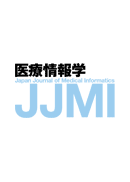All issues

Volume 31 (2011)
- Issue 1 Pages 3-
Volume 31, Issue 1
Displaying 1-4 of 4 articles from this issue
- |<
- <
- 1
- >
- >|
Original Article-Notes
-
N Suzuki, K Ohshige, S Imaki, T Yamamoto, H Kinoshita, I Michishita, N ...2011Volume 31Issue 1 Pages 3-12
Published: 2011
Released on J-STAGE: February 13, 2015
JOURNAL FREE ACCESS【Aims】 To assess the Priority Identifying System for Emergency Ambulance Calls. 【Methods】 The priority identifying results by call takers for emergency ambulance calls were compared to the Doctors' diagnosis. 【Results】 In 27 months 260,854 emergency ambulance calls were categorized to A+ (n=17,004), A (n=74,535), B (n=100,335), C+ (n=49,529), C (n=19,451). Doctors' diagnosis were dead cases (n=2,731), very serious cases (n=7,892), serious cases (n=14,547), moderate cases (n=86,327), mild cases (n=149,357). The rate of undertriage about life-threatening conditions was 3.0%. The overtriage rate was 71.1%. Revised algorithm brought the overtriage rate 11.8% down and the undertriage rate 1.8% up. 【Discussions】 The propriety of the algorithm could be improved by revising. Despite the progress of call takers in catching points from emergency calls, it was difficult to find out the deterioration after a caller hangs up and detect the shock condition of callers. It was not enough to use the information caught by call takers at the scene of emergency and in emergency rooms. 【Conclusions】 It is necessary to more improve the algorithm and the call taking skills for better emergency services.View full abstractDownload PDF (662K) -
A Maeyashiki, M Akahane, H Sugiura, K Onitake, Y Ohkusa, N Okabe, A Ha ...2011Volume 31Issue 1 Pages 13-24
Published: 2011
Released on J-STAGE: February 13, 2015
JOURNAL FREE ACCESSSignal detection methods using data, such as adverse drug reactions reporting, have been developed for post-marketing drugs. These methods have been examined in Japan by the Pharmaceuticals and Medical Devices Agency. However, no survey method has been established to study the food borne health disorder resulting from post-marketing foods. In this study, we utilized the post-marketing surveillance for the early detection of food borne health disorder and examined the feasibility of post-marketing monitoring. We obtained consent from the union members of the Japanese Consumers' Co-operative Union (JCCU) and collected product purchase data at the JCCU to conduct a daily health survey using Internet questionnaires. We calculated the signal detection indexes for some combinations of foods and symptoms, referring to the procedures for adverse drug reaction, and detected several signals that indicated health disorder. Our results demonstrate the feasibility of post-marketing monitoring. In the future, we will determine the threshold of alert about health problems using various signal detection methods to improve the precision of analysis based on post-marketing monitoring.View full abstractDownload PDF (537K) -
M Kagawa, Y Yoshida, M Kubota, A Kurita, T Matsui2011Volume 31Issue 1 Pages 25-36
Published: 2011
Released on J-STAGE: February 13, 2015
JOURNAL FREE ACCESSThis research aims to maintain accurate determination of heart and respiratory rates despite a subject's change of position and sleeping posture in bed, in a non-contact vital signs monitoring system for elderly people using two microwave radars that are placed beneath the mattress of a bed. To challenge the three problems in the Doppler radar based measurement, that is, Null detection point problems, harmonics and intermodulation interference and the limitation in the coverage area of radars, we propose a new real time selection method to choose the best radar-output channel out of four signals (I and Q cannels of each radar). Based on a spectrum shape analysis (SSA), we select the most appropriate channel with the least number of large peaks and with the largest peak-to-peak ratio in the FFT spectrum. A prototype of the system was set up at a nursing home and field tests were carried out with elderly subjects. The result of eight hours clinical test showed high correlation coefficients (r=0.61∼0.73) between heart rate determined by the proposed system and that derived from Holter ECG in spite of the frequent positional change in bed. This method achieved higher accuracy of heart rate detection than that of conventional methods. This system without any psychological and physical burden on elderly people is ideal as a new monitoring system in this time of limited resources in healthcare.View full abstractDownload PDF (739K) -
A Okagaki, Y Koretsune, S Nakajima, A Wada, H Kusuoka2011Volume 31Issue 1 Pages 37-48
Published: 2011
Released on J-STAGE: February 13, 2015
JOURNAL FREE ACCESSWe are currently using a “Card-type” electronic patient record (EPR) system, which has been created by adding a customized interface layer between FileMaker Pro and the vendor-made EPR system. To investigate the ideal description method for EPRs, we analyzed the nighttime outpatient records and evaluated the quality of description and that of medical performance. In our hospital, the 1st and 2nd grade residents take charge of the nighttime outpatients. From April 2006 to March 2007, “Roll paper style” EPR was used. After April 2007, “Card-type” EPR was equipped for nighttime outpatients. We analyzed the data in EPRs for nighttime outpatients to determine whether proper descriptions were being provided in the important fields. We also evaluated the accuracy of diagnosis and treatments. The assessments showed that the number of the character to describe patient's record by “Card-type” EPR were twice compared with “Roll paper style” EPR, and the important aspects were well described in “Card-type” EPR. “Good performance” was achieved in “Card-type” EPR. Using our EPRs, many important aspects could be described, and the diagnosis and treatment was shown to be satisfactory. The prepared input fields may improve the medical performance.View full abstractDownload PDF (756K)
- |<
- <
- 1
- >
- >|